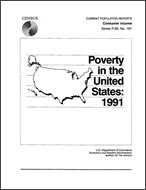Poverty in the United States: 1991
Poverty in the United States: 1991
Note
In January 1992, a new educational attainment question comparable to that used in the 1990 census of population was introduced in the Current Population Survey. Consequently, data on educational attainment from the 1992 CPS are not directly comparable to CPS data for prior years. A discussion of the change in the educational attainment item can be found in the descriptive text of this report.
The estimates for 1991 in this report are inflated to national population controls by age, race, sex, and Hispanic origin. The population controls are based on results of the 1980 census carried forward to 1991. The estimates in this report, therefore, may differ from estimates that would have been obtained using 1990 census results brought forward to the survey date. Population controls incorporating 1990 census results will be used for survey estimation beginning in 1993.
Introduction
This report presents social and economic characteristics of the population below the poverty level in 1991 based on the March 1992 Current Population Survey (CPS). The poverty definition used in this report is that adopted for official Government use by the Office of Management and Budget and consists of a set of money income thresholds that vary by family size and composition. Poverty status is based on responses to income questions which in the March CPS refer to pre-tax income received in the previous calendar year. Families or individuals with income below their appropriate poverty threshold are classified as below the poverty level. These poverty statistics exclude inmates of institutions, Armed Forces members in barracks, and unrelated individuals under 15 years of age. Poverty thresholds are updated every year to reflect changes in the Consumer Price Index. For example, the average poverty threshold for a family of four was $13,359 in 1990 but $13,924 in 1991. Average poverty thresholds in 1991 varied from $6,932 for a person living alone to $27,942 for a family of nine or more members. The poverty definition is based on pre-tax money income only, excluding capital gains, and does not include the value of noncash benefits such as employer-provided health insurance, food stamps, or Medicaid. For further discussion, see the section entitled "Collection and Limitations of Poverty Data.''
The data in this report consist of cross-classifications of poverty status by such characteristics as age, race, Hispanic origin, family relationship, educational attainment, work experience, and type of income received. Although the primary focus of the tables is on the United States as a whole, some tables also present data by region and type of residence. In addition, appendix D presents poverty estimates and rates for States for the years 1981 through 1991 based on CPS figures.
In the text, the terms "poverty population", "poor", and "below the poverty level" are used interchangeably, as are the terms "nonpoor" and "above the poverty level". Characteristics such as age and marital status are as of the survey date (e.g., March 1992), while income, poverty status, and work experience data refer to the whole previous calendar year (e.g., 1991). In the report text, the year cited refers to the "income" year.
Others in Series
Publication
Publication
Publication






